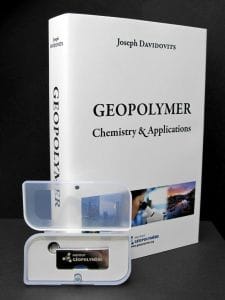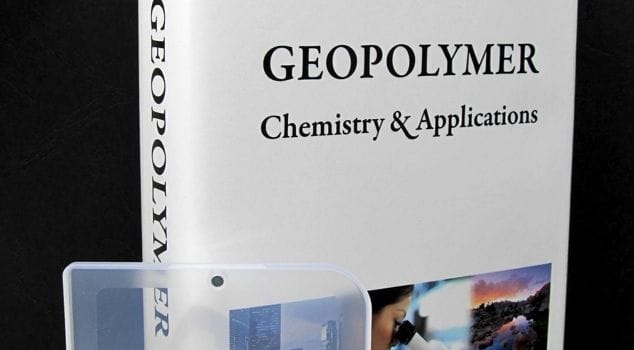Professor Joseph DAVIDOVITS presents his first course for beginners in geopolymer chemistry and applications.

ISBN: 9782951482036
Buy your copy of the Video Tutorial at The Geopolymer Shop
With your order, you will receive two items: the new edition of the book Geopolymer Chemistry and Applications and a USB memory stick with 5.5 hours of video tutorials (the Geopolymer for Newcomers series) and up to 10 hours of video bonuses for a total of 15 hours of videos.
Watch this short presentation, it includes small excerpts, and a view of the Geopolymer Institute laboratory.
What is the content of this video tutorial ?
This video tutorial is divided in 9 topics. Its purpose is to give you an introduction, an insight on geopolymer science in general. It is aimed at university professors, doctorates, master students as well as self-learning researchers in the industry. Although you get each concepts fully developed in the book Geopolymer Chemistry and Applications, you may need to look at additional scientific knowledge in reference textbooks on materials science, chemistry and physic. This tutorial is therefore a good supplement for your understanding of all these concepts, and for teachers it is a good help in the learning process of geopolymer chemistry.
As a bonus, you will find “Building the pyramids of Egypt”, Joseph DAVIDOVITS a 1h30 conference on his famous theory on how the Egyptians pyramids were built with re-agglomerated limestone.
What are these files ?
The videos are readable in any computer that can play MPEG4 H.264 AVC files. Most recent computers, tablets, phones, and some televisions can play them flawlessly. You can use for example the free players Apple QuickTime or VLC or Mplayer or many other video players. They are high definition videos, so your computer should be powerful enough to open them. Download this small excerpt to check the compatibility with your computer; it is the exact size and format of what you will receive. Please, do this test before ordering.
sample-geopolymer-video-tutorial.mp4 – 7.95 MB – 47s – 1024x640p – MPEG4 H.264 AVC
Outline of the tutorials
Topic #1: from invention to industrialization; 1972-2008: 36 years of research, development and applications
The course shows how the development of the geopolymer science concept was governed by the need to solve global technological problems in the industrial fields of extractive minerals, ceramics, cements, building materials, decorative stones and restoration works, fire and heat resistant composites, high-tech composites for aerospace, aircraft, naval and automobile, radioactive and toxic waste containment, thermal insulation.
It further provides a clear distinction between geopolymer and alkali-activated materials and highlights some historical milestones.
Upon completion of this course, you will be able to make a clear cut between geopolymer technologies and low-tech/alkali-activated systems.
Topic #2: The mineral geopolymer concept
The course discusses the differences between the ionic and covalent bonding concepts. It introduces the molecular representation for geopolymeric structures based on the most recent results of physicochemical science.
Upon completion of this course, you will be able to describe the fundamental principles and concepts of geopolymer science and technology.
Topic #3: Macromolecular structure of natural silicates and aluminosilicates
This course describes the numerous natural minerals and pinpoints their similarities to geopolymeric molecules (monomers, dimers, trimers, etc..) and macromolecules (polymers). It involves:
– Ortho-silicates, ring silicates,
– Linear poly-silicates: pyroxene, amphibole
– Sheet poly-silicates: kaolinite, pyrophillite, muscovite
– Framework poly-silicates: quartz, feldspars, feldspathoids, zeolites
Upon completion of this course, you will be able to explain the properties of the minerals used as raw-materials in geopolymer manufacturing.
Topic #4: Scientific tools, X-rays, FTIR, NMR
This course selects which analytical method is the most appropriate for the study of geopolymers, namely Nuclear Magnetic Resonance Spectroscopy.
Topic #5: Macromolecular structure of Soluble Silicate, Poly(siloxonate) with Si:Al=1:0
This course revisits an old industry namely that of waterglass, a basic geopolymeric chemical ingredient. It involves:
– History of soluble silicates (waterglass), manufacture,
– Macromolecular structure of (Na,K)–silicate glasses,
– Hydrolysis, depolymerization of solid silicates
– Structure of poly(siloxonate) solutions (waterglass)
– NMR spectroscopy, macromolecular structure, identification of soluble species
– Density, Viscosity, pH, alkali silicate powders
Upon completion of this course, you will be able to understand the differences between Na-silicates and K-silicates and how to apply this new knowledge in the design of high-quality geopolymeric products.
Topic #6: Macromolecular chemistry of Metakaolin MK-750 and related geopolymers with Si:Al=1-3
This course follows the various structural changes of the mineral kaolinite into metakaolin and their implications in the geopolymerization mechanisms. It describes:
– Dehydroxylation mechanism of kaolinite
– Chemical mechanism, ortho-sialate molecules
– Kinetic, Chemical attack, Exothermic reaction
– Formation of Na-based geopolymeric frameworks: nepheline, albite, phillipsite
– Formation of K-based geopolymeric frameworks: kalsilite, leucite
Upon completion of this course you will be able to :
– Outline the identification and the study of metakaolin raw materials for geopolymeric precursors with selected instrumental methods.
– Identify the reaction mechanism from monomers, oligomers to polymers, kinetics and geopolymerization parameters.
Topic #7: Low-energy, Low-CO2 geopolymer cements
This course provides a thorough presentation and discussion on the basic knowledge about geopolymer cements and related building products based on the by-products of industrial and mining activities or Coal-Power-Plants: fly ashes. It comprises:
– MK-750 / slag-based geopolymer cement
– Rock-based geopolymer cement
– Fly ash-based geopolymer cement
– Greenhouse CO2 mitigation with geopolymer cement: Examples of low CO2 mitigation with geopolymer cements
Upon completion of this course, you will be able to describe the fundamental principles and concepts allowing the use of geological outcrops as well as mineral by-products and tailings, fly ashes, in low-energy and low-CO2 geopolymer cements manufacture.
Topic #8: Low-energy, Low-CO2 geopolymer ceramics
This course offers a comprehensive review of the impact of Geopolymer technology on the manufacture of Low-energy ceramics and bricks. It involves:
– Geopolymerization mechanism of kaolinite under co-valent bonding concept
– Geopolymeric setting at temperature below 65°C, 80°C and 450°C
– Resistance to water; physical properties
– Application to archaeological ceramics: 25.000 year-old geopolymer ceramic: Venus of Dolni Vestonice
Upon completion of the course, you will be able to apply the geopolymeric ceramic concept to implement modern Low-energy ceramic processing for the production of regular ceramic tiles (glazed) or fired bricks.
Topic #9: User-Friendly Systems
Although geopolymerization does not rely on toxic organic solvents but only on water, it needs chemical ingredients that may be dangerous. Some of them may be classified as user-hostile systems and therefore require some safety procedures.
Upon completion of the course, you will be able to understand the absolute necessity of implementing user-friendly geopolymeric systems.
Bonus
Geopolymer Webinar
This is a recording of a 5 hours presentation of Joseph Davidovits in October 2013 on geopolymers in general, focusing in industrial applications and science. It is a good introduction on how to approach this topic the right way.
GeopolymerCamp Keynotes
Joseph Davidovits presents each year during this conference a state of the R&D and industrialization of geopolymers at large.
Building the pyramids of Egypt
Joseph DAVIDOVITS presents his famous theory on how the Egyptians pyramids were built with re-agglomerated limestone.
LTGS brick conference
Joseph DAVIDOVITS presents the manufacture of bricks with low energy at the Ceramics and Brotherhood Symposium, Verona, Italy, in July 2008.
Davya 60 cement tutorial and Datobe ceramic tutorial
Two short “how-to” on how to manipulate a geopolymer cement and a geopolymer ceramic, with tips and tricks the way a lab technician of the Geopolymer Institute is doing it.
Buy your copy of the Video Tutorial at The Geopolymer Shop
INCLUDED WITH YOUR ORDER: Proceedings of the Geopolymer 2005 World Congress
(Geopolymer, green chemistry and sustainable development solutions)
The USB memory stick contains the proceedings of the World Congress Geopolymer 2005, held in France and in Australia, on geopolymer science, technology and applications. More than 180 people attended the congress, 85 international research institutions and companies presented a total of 75 papers. They cover a wide scope of topics ranging from geopolymer chemistry, industrial waste and raw material, geopolymer cement, geopolymer concrete (including fly ash-based geopolymers), applications in constructions materials, applications in high-tech materials, matrix for fire/heat resistant composites, and applications in archaeology.
The Proceedings book (Geopolymer, green chemistry and sustainable development solutions) is out of print. The USB memory stick contains all contributions received (additional extended abstracts, and some pictures of the event are included). All papers found in this USB memory stick are in colors, and are the exact copies of the printed book, so you can use them as a reference. It is also compatible with PC, Mac and Unix systems, all files are in standard PDF format. You can print, copy these papers, and use the search engine to find a particular word.
GET 3 PROCEEDINGS IN 1 SINGLE ORDER
A unique collection of scientific articles
133 papers – 1190 pages
ISBN: 9782951482005
As a FREE BONUS, the USB memory stick includes the proceedings of Geopolymer ’88, and Geopolymer ’99. We do this because these proceedings are out of print. They are the exact copies of their printed versions, so you can still use them as a reference and seek for the right paper at the right page.


